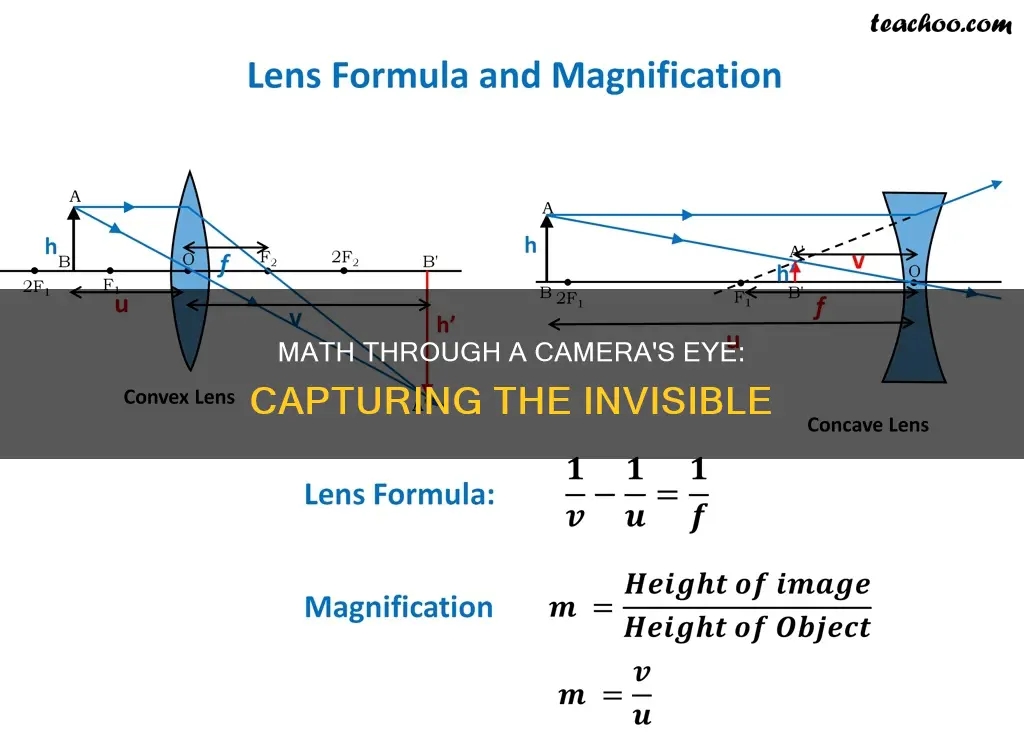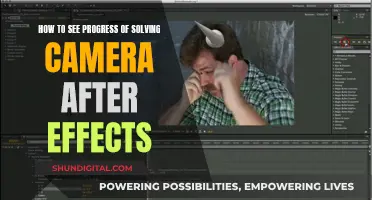
Mathematics plays a crucial role in photography, with various camera settings relying on different mathematical rules. One of the primary mathematical concepts in photography is fractions, which are used in the Rule of Thirds for photo composition. This rule involves dividing an image into thirds, creating a 3x3 grid, and positioning the subject at the intersection of the grid lines. Another important aspect is ISO settings, which determine the camera's sensitivity to light and follow a geometric progression, with each subsequent value twice as strong as the previous one. Aperture settings, also known as F-Stop, follow a similar pattern, with the lowest F-Stop value indicating a fully opened aperture. Shutter speed, measured in seconds or fractions of seconds, also follows a geometric progression, with each value capturing a different amount of light. Additionally, the Rule of Thirds can be taken further with the Golden Mean, a ratio of 1:1.618 found in nature and art, creating a more eye-pleasing composition. These mathematical concepts, among others, allow photographers to turn their images into artistic creations by controlling depth, motion capture, and image graininess.
| Characteristics | Values |
|---|---|
| Shutter speed | 1/1000, 1/500, 1/250, 1/60, 1/30, 1/15, 1/8, 1/4, 1/2 and 1 |
| Aperture | Depends on the diameter of the lens or mirror |
| Focal length | 28mm, 55mm |
| Rule of Thirds | Composition rule for photography |
| F-stops | 1, 1.4, 2, 2.8, 4, 5.6, 11, 16, 22, 32, 45, 64, 90, 128 |
| Field of View (FOV) | Depends on Focal length and Sensor Size |
| Magnification | Depends on Focal length and Subject distance |
What You'll Learn

Shutter speed
- Brightness: A longer shutter speed lets in more light, resulting in a brighter photo. A faster shutter speed lets in less light, resulting in a darker photo.
- Motion: A longer shutter speed will blur moving subjects in your photo, creating a sense of motion or speed. A faster shutter speed will freeze motion, even from fast-moving objects.
In addition, shutter speed can be used to create dramatic effects by either freezing action or blurring motion. For example, a fast shutter speed can be used to eliminate motion from fast-moving objects like birds in flight or cars driving past. On the other hand, a slow shutter speed can be used to blur the moving wheels of cars and motorbikes in advertisements, giving a sense of speed and motion.
Target's Camera Surveillance: Who's Watching?
You may want to see also

Aperture
Small numbers represent large apertures, and large numbers represent small apertures. This is because aperture is a fraction. For example, an aperture of f/16 is much smaller than f/4.
The other critical effect of aperture is depth of field. Depth of field is the amount of your photograph that appears sharp from front to back. Some images have a “thin” or “shallow” depth of field, where the background is completely out of focus. Other images have a “large” or “high” depth of field, where both the foreground and background are sharp.
Spot Hidden Pinhole Cameras: Quick Tips and Tricks
You may want to see also

Focal length
The focal length of a lens is a fundamental parameter that measures how strongly a lens converges or diverges light. It is the distance, usually in millimetres, between the "nodal point" or "optical centre" of the lens and the camera's sensor. The nodal point is where light converges in a lens.
The focal length of a thin lens in air is the distance from the centre of the lens to the principal foci (focal points) of the lens. For a converging lens, the focal length is positive and is the distance at which a beam of collimated light will be focused to a single spot. Conversely, for a diverging lens, the focal length is negative and is the distance to the point from which a collimated beam appears to be diverging after passing through the lens.
In photography, lenses can be divided into two types: prime and zoom lenses. Prime lenses have a fixed focal length, meaning that the perspective of the image can only be changed by physically moving the camera closer or further from the subject. Zoom lenses, on the other hand, have variable focal lengths, offering a range of focal lengths to choose from.
The focal length of a lens also determines its magnification. In most photography and all telescopy, where the subject is essentially infinitely far away, a longer focal length leads to higher magnification and a narrower angle of view. Conversely, a shorter focal length results in lower magnification and a wider angle of view. However, in applications such as microscopy, where magnification is achieved by bringing the object close to the lens, a shorter focal length leads to higher magnification because the subject can be brought closer to the centre of projection.
Lenses can also be categorised into three broad categories according to their focal length: wide-angle, standard, and telephoto lenses. Wide-angle lenses have a focal length up to around 35mm, offering a wider field of view than the human eye, making them ideal for large group portraits, architectural photography, and landscape photography. Standard lenses have a focal length of around 50mm, providing a "natural perspective" similar to that of the human eye, and are often used for travel and portrait photography. Telephoto lenses have a focal length of around 85mm or more, producing a more tightly framed view than the human eye, making them suitable for photographing distant subjects.
The focal length of a lens is an important concept in photography, as it determines the lens's field of view and magnification, ultimately influencing how much of the scene is captured and how large or small the subject appears in the photo.
Philips 65-inch 4K TV: Where's the Camera?
You may want to see also

Field of view
The field of view (FOV) is the maximum area of a sample that a camera can image. It is related to the focal length of the lens and the sensor size. The focal length of the lens describes the distance between the lens and the focused image on the sensor. As light passes through the lens, it will either converge (positive focal length) or diverge (negative focal length). Within cameras, the focal length is predominantly positive.
The sensor size is determined by the number of pixels on the sensor and the size of the pixels. Different-sized pixels are used for different applications, with larger pixels used for higher sensitivity and smaller pixels used for higher spatial resolution.
The FOV can be expressed as either the angular view or the dimensional field, which can be horizontal width, vertical height, or diagonal. Angular FOV is commonly stated as the diagonal (which is the circular lens view). The angle is independent of distance (the angle remains the same at any distance). Dimensional FOV (in feet, meters, etc.) is computed at one specific distance (of the same units).
The FOV accuracy is dependent on the known accuracy of distance, focal length, and sensor size dimensions. The focal length and sensor size determine the angle of view, which in turn determines the FOV. The FOV is the area of the inspection captured on the camera's imager. The size of the FOV and the size of the camera's imager directly affect the image resolution.
The FOV can be calculated using the following formula:
> Sensor dimension (mm) x Focal length (mm) = Field dimension x Distance to Field (feet or meters)
The FOV can also be calculated using trigonometry:
> FOV = 2 x arctan (sensor dimension (mm) / 2 x focal length (mm))
The FOV can be measured using optical tests. During the test, light is focused from a black body (an object that absorbs all light that falls on it) onto a test target at the focal place. By using a set of mirrors, a virtual image can be created that is at an infinitely far distance. This allows the FOV dimensions (i.e. vertical and horizontal distances) to be measured without knowing the lens focal length or sensor size.
The FOV can also be calculated using a FOV calculator. However, it is important to note that the accuracy of the results depends on the accuracy of the input data.
How Cameras Can Help Detect Hidden Plumbing Lines
You may want to see also

Rule of thirds
The rule of thirds is a foundational principle of photography and cinematography that can transform images from ordinary snapshots to visually captivating works of art. It is a type of off-centre composition that gives structure to photographs and makes them more appealing.
To apply the rule of thirds, imagine a 3x3 grid dividing your image into nine equal parts with four lines – two equally spaced horizontal lines and two equally spaced vertical lines. The rule of thirds suggests that the important elements of a photograph should be placed along these lines or at their points of intersection. This creates a more dynamic and interesting image than simply centring the subject.
When shooting a portrait, you would place the eyes of your subject along the upper horizontal line. For a landscape image, you would place the horizon along the top or bottom horizontal line. This helps to balance the image and gives a sense of dynamism, allowing the viewer to go on a visual journey through the scene.
The rule of thirds is a guideline rather than a strict rule and can be broken for artistic effect. For example, it can be more visually interesting to place a symmetrical subject in the centre of the frame. However, understanding and practising the rule of thirds will improve your compositional skills and give you a solid starting point for creating captivating photographs.
Unsecured Cameras: Is Watching a Crime?
You may want to see also
Frequently asked questions
The Rule of Thirds is a basic rule of photography that helps photographers compose their images. Imagine a grid with dimensions 3x3, creating nine rectangles, and place the important subjects or parts of the subject at the points where the grid lines intersect.
ISO measures the camera's sensitivity to light. Higher ISO settings mean the camera is more sensitive, and common ISO values follow a pattern of geometric progression, e.g. ISO 100, 200, 400, 800, 1600... Each subsequent ISO value is twice as strong as the previous one.
Aperture settings can be confusing because a higher number means a smaller opening. The typical F-Stop numbers are f/1.4, f/2, f/2.8, f/4, f/6, f/8... These numbers follow a geometric progression, with each subsequent number being the previous one multiplied by the square root of 2.
Shutter speed measures how long the shutter stays open, and it's usually measured in seconds or fractions of a second. Common shutter speeds include 1, 1/2, 1/4, 1/8, 1/15... up to 1/5000. These also form a geometric sequence, with the denominators doubling.
The Golden Mean is the ideal ratio of 1:1.618, found in nature, economics, and even DNA. In photography, the Golden Mean is applied by subdividing your image according to this ratio, creating a more eye-pleasing composition than the Rule of Thirds.







